
Typical Art. The Temptations of Pierre Molinier
26/09/2015
- The Temptations of Pierre Molinier -
Richard Saltoun Gallery, London
Through 2 October, 2015
“In accordance with the thoughts of Bataille, and predating them, his novels occupy the same space, and were published under a pseudonym at first, such as his debut ‘Story of the Eye’; these ideas may also include some of the writings of Robert Desnos, Marcel Duchamp and Louis Aragon (‘Irene’s Cunt’), Joyce Mansour’s works, Hans Bellmer’s drawings, the paintings of Salvador Dali or Pierre Molinier. Inside this evidently strong surrealist tradition that is nourished by eroticism, there is a noticeable tendency for defending perversions: marginal, delayed, sometimes clearly falling out of its time, but still very real. (...) Masturbation, fetishism, necrophilia, bestiality, coprophilia, fellatio, sodomy... riddle games on the topic of sexuality... are much more modest in regard to the details of such deviations, but nevertheless they admit them openly.” This discussion is taken from Jacqueline Chenieux-Gendron’s book “Surrealism”; in it, the artist Pierre Molinier is only mentioned three times, and all those times in passing. Molinier was three years younger than Georges Bataille, who is mentioned multiple times by Chenieux-Gendron in her book, and four years older than Dali, who is one of the main characters in “Surrealism”. Finally, the father and founder of surrealism, Andre Breton, was one year older than Bataille, and the pair had a big argument in the end, (“Bataille has a fly sitting on his nose. And he talks to it,” wrote Breton during the worst of the fight) and was therefore four years older than Molinier. All in all, they were all one generation. Although the first “contact” between Molinier and Breton (let us call it “historical”) occurred in 1955. Therefore it makes sense to describe the following plot from this chronological point, keeping it always in mind.
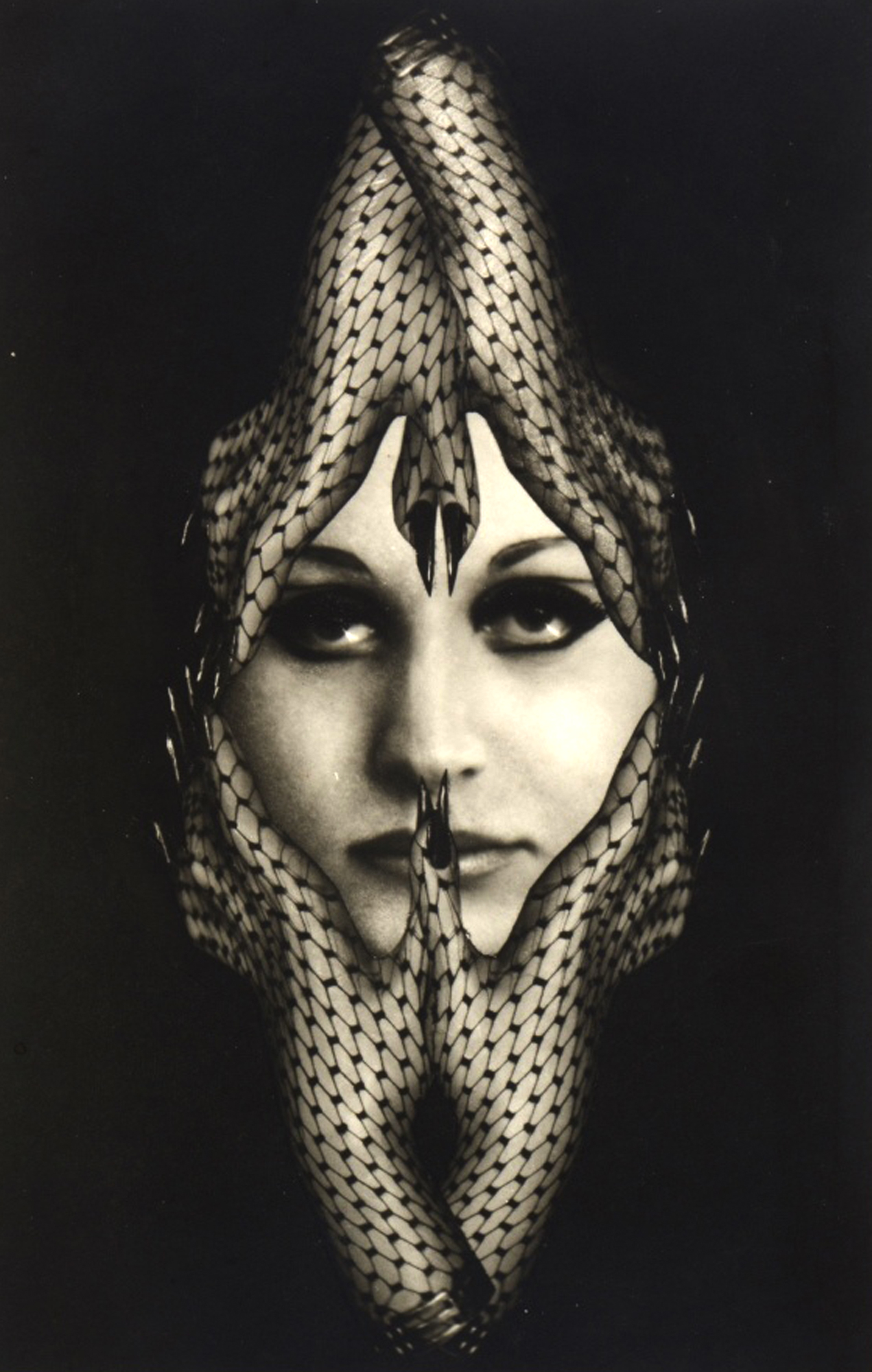
Pierre Molinier. Hanel 1. planche 30 du Chaman. 1967
During the time of Breton throwing lightning and thunder at his apostates, collecting his surrealist regiment and leading it to victory in the revolution, when Bataille was writing “Story of the Eye”, “The Solar Anus”, and was also publishing the magazine “L’Acephale”, when Dali was filming “An Andalusian Dog” together with Bunuel and drawing whatever he was drawing, Pierre Molinier lived in Bordeaux, where he moved in 1920 with parents from Agen. His father was a wall-painter, and his family was proper Catholic. Pierre Molinier studied to become an artist, first he followed in his father’s footsteps, but later started painting landscapes. His landscape paintings were done in a soft impressionist style with a little addition of post-impressionism, they were easy on the eye both culturally and for the bourgeoisie. In the 30s Molinier’s heroes became the Symbolists, although at that time Bordeaux had already heard of the commotion cause by the Surrealists in Paris. Before the war Molinier worked in the style of Gustave Moreau, in which fractions of hinduism, Ancient Egyptian religions and even shamanism could be recognized. His works were surrounded by an esoteric flair, and that wasn’t coincidental. Molinier entered some esoteric society back in the 20s; some of his biographers called it the masons, others avoided such concrete interpretations. Molinier’s life-changing break came when he turned 50. He prepared a burial cross for himself which had the date of his birth (13 April 1900) and an unfinished date of his death (1950). There was also an inscription which read “Here lies a man without morals”. He secured the cross in the soil of one of the forests near Bordeaux (perhaps the more advanced reader remembers the description of these forests in the catholic novels by Francois Mauriac such as “Therese Desqueyroux”). Mauriac was born in Bordeaux 15 years before Molinier, a different generation.
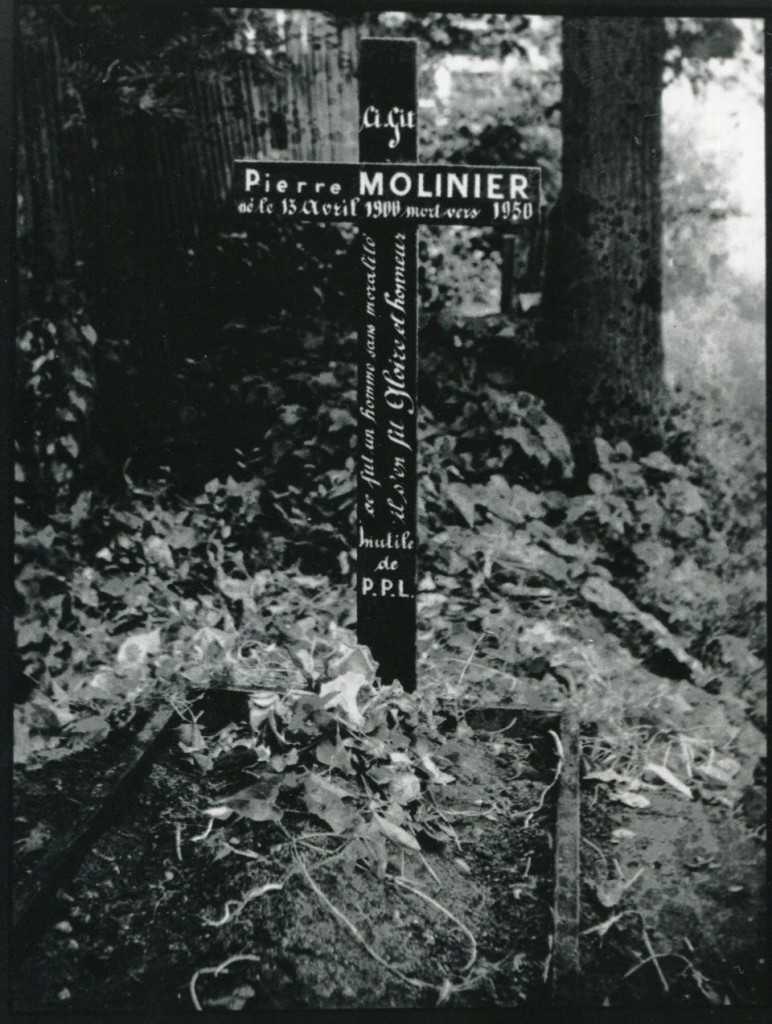
Granted, it is not fair to say that these changes occurred suddenly. When Pierre Molinier was 20 years old, he was a homosexual, a transvestite and, of course, a narcissist. A provincial aesthete forever adoring Aubrey Beardsley, Oscar Wilde, and with a fascination with the cult of death as an absolute work of art, a typical sort of thing for these kinds of people. Molinier was 18 years old when his beloved sister died. When her body lay in the coffin at home, Pierre secretly got into that room, pushed his sister’s appropriately funereal strict dress up and started masturbating: “Even in death she was beautiful. I shot sperm on her belly, her legs, and on her funereal dress which she had on her. She took the best part of me with her to the other side.” Albeit all these modest peculiarities, Pierre Molinier led a pretty normal life until 1950, at least on the surface. Only after burying himself in the forest situated in the Gironde estuary, he was as if reborn, and he was reborn into the form that would bring him fame, although perhaps somewhat limited and refined. The combination of the refined and the limited, and the social consequences of both categories, will be discussed later.
In 1950 Pierre Molinier changed his way of life, becoming not exactly a recluse, but certainly a devotee of an ascetic, reclusive, austere lifestyle, a priest of his own cult of a variety of perversions, sorry to use such an old-fashioned expression. At home he created a kind of photo studio which he named in an old-fashioned, beautiful and slightly vulgar way, “boudoir”. That is where he made his new art. Just technically this art could be divided into three categories. The first was painting, quite well-known to Molinier. The paintings became more and more frightening, untamed and “surreal” in the worst case scenario of this more or less monotonous type of painting. The interesting surrealist artwork is always cold, removed, distant, such as Max Ernst, Magritte, some others. But in the case of Molinier’s paintings the surrealism before our eyes is inflamed, hot, anxious, passionate, which is what makes it dreary like in the zoo where the smelly, tired and unhappy lions are being chased around the arena. Sure they could snatch a piece of you. They could even maul you into tiny pieces if they want to. But they do not want to maul anyone, and we are not exactly excited by that prospect. You may imagine yourself as an early Christian martyr in the arena with wild beasts as much as you want, but we are just the bourgeoisie, ceremoniously sitting with tickets for the seats bought according to the amount of money they earned by the sweat of their brow. The second category of “Molinier’s new art” was photography. These were posed photos, some of them blurry, either on purpose or due to the absence of professional skills. His photos present antique fetishism, BDSM, other darling little things from decadent bordellos, things that 65 years ago were still half-banned and agitated the minds of the minor, middle and large bourgeoisie, and partly even the minds of the intelligentsia and the aristocracy. Bataille diligently wrote precisely about this; except for the aforementioned “Eyes” and “Anus”, let us remind ourselves of “The Blue of Noon”. Actually “perversions” became very fashionable in France in the middle of the last century; in the 19th century they obviously resided in the well protected secret recesses of marginalized society, they interested the romantics, then the decadent and the symbolists, until finally in the 20th century the surrealists started to discuss perversions at full volume. It was the surrealists that brought Marquis de Sade to a wider cultural circle, without whose name not one of the self-respecting French thinker from the Breton and Bataille generation (and of course the later ones) could take a single step. Everyone wrote about de Sade: from Pierre Klossowski to Albert Camus, from Simone de Beauvoir to Maurice Blanchot. A little bit later, in the 1950s, Alain Robbe-Grillet began his literary career, the same one who sang monotonously of the conveyer manipulations of the flesh. Therefore Pierre Molinier happened to be in not such a terrible company; it is quite another matter that our provincial boy partly invented the bicycle, and in some way his awkward handmade bicycle appeared to be more interesting than the many conveyer-made things. Molinier’s photographs are either of him, a female model, or mannequins. There are also different combinations of the first, the second and the third. Most often than not these combinations belong to the third genre of the “new Molinier”: his collages.
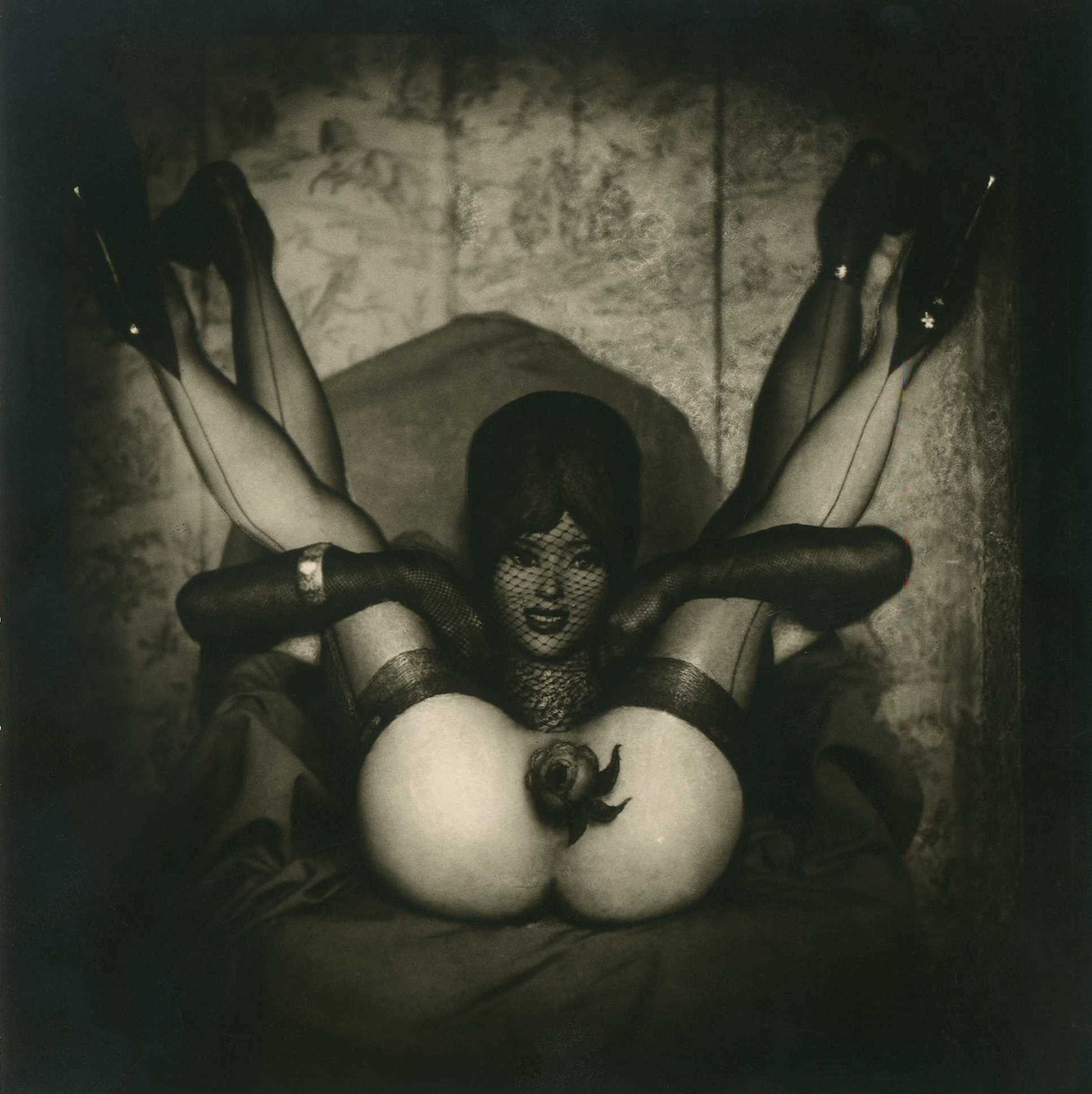
Pierre Molinier. La rose noire, planche 23 du Chaman. 1960
Examples of all three genres are now exhibited in the London gallery Richard Saltoun with a blanket title “The Temptations of Pierre Molinier”. The exhibition has two medium-size halls, and, as it always happens, they are ideally empty with idealistic white walls with yellowing small scale photographs in yellowing frames, sometimes with paintings. The second hall has a display where you can watch and listen through headphones a rather curious documentary by Dominique Roland called “Les jambes de Saint Pierre”. The film features the actual voice of Molinier (the artist’s narcissism had no bounds, he recorded himself); during the moments when you hear his fragile phrases uttered with slight shakiness and even a tender aging squeakiness, the screen shows a 1960s specimen of a recorder. The recorder is running reels; more attention is paid to the large “stop/start” keys than to the voice; at the beginning the keys were white but from time passing they started yellowing and therefore acquired a noble yellow tone of ivory. That is how modernism is aging. Although one wall of the second hall is burgundy red, which not only reminds us of the name of the town (*translator’s note: in Russian the color burgundy is based on the name Bordeaux) where all these artworks were created, or the color and name of the wonderful drink which is made in the chateaux surrounding the city, but also it echoes the palette of the establishments so dear to Molinier. Red walls obviously mean brothels, who would argue that? By the way, Roland’s film (42 minutes!) I watched in full at the exhibition. I was touched by the story of one of the old artist’s favorite models. It seems that she was a dominatrix prostitute; the old man was so enamored of her that he opened a whole brothel for her with his own money, masquerading as a cafe (after all, the city was respectable and had all those catholics and protestants, and even the God-fearing Mauriac was from there also). “She wasted all the money pretty quickly”, remarks Molinier in the film, either with a laugh or a whimper. On the other hand he had another more disciplined muse, about whom you cannot find out at the exhibition, and in the plethora of literature about Molinier you also might not find out much about her. Nevertheless, the disciplined muse was called Hanel Koeck, a German woman about 20 years old, who was studying art at the time. Pierrer Molinier met her in 1967, thinking that she looked like his late sister, he photographed her extensively (the photos are either of him photographing her, or the other way round). Koeck found herself in the midst of Viennese Actionists where she continued to step over and cross the boundaries of the legal, respectable and sacrilegious. In 1967, in Vienna, Koeck organized a performance called “Oh! Marie... Mere de Dieu” which featured the plot of one of Molinier’s paintings by the same name. She was crucified, sodomized, and to be honest it was truly realistic art!
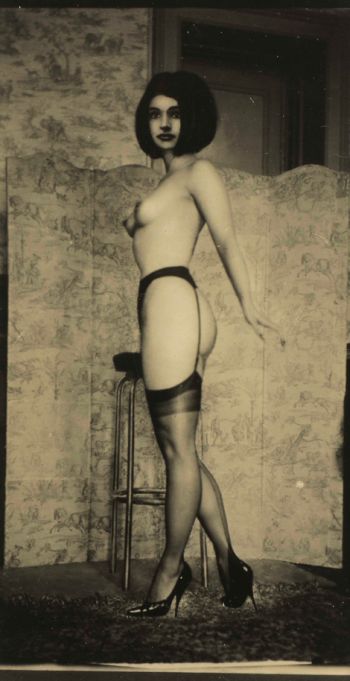
Pierre Molinier. Portrait de Hanel
But let us return to the exhibition at Richard Saltoun. I have fundamentally tried not to describe it by turning on the conveyor belt of such words as “transgression”, “narcissism”, “libido”, “androgynous consciousness” and others, a hard feat for the writer. Many texts of this conveyor belt exist, I will point you to an interesting review of a previous exhibition of Molinier’s artwork in London (1993), and also to a small pleasantly amateur essay by Mark Alice Durant on the website saint lucy. I would have also liked to include Dominique Roland’s film here but alas I could find it neither on youtube nor anywhere else. Therefore the choices that remain are limited. I can either make a quick summary of art objects seen by me, or I can come up with theories about them using a different thesaurus than the one mentioned above. However, there is another option, to guide the discussion into a more interesting dimension than pure art history or the impure cultural studies. I will try to go through all the options quickly.
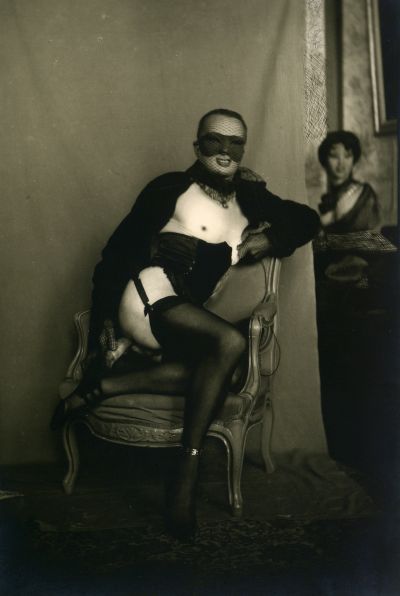
Pierre Molinier. Eperon d’amour. 1960
Describing the artifacts. They are funny in their wish to be something, anything but what they have become now, in other words the relics of a specific historico-cultural period. The images, if we are talking about photography and collages (I have already discussed Molinier’s paintings earlier), can be divided into a few types. Some of them, the most fun ones, are actually the collages, in which Molinier’s legs (in black stockings and shoes with skyscraper-high heels, which in London are called “fuck me shoes”) are stuck between other legs, women’s, real or mannequin’s, all wearing the same stockings. The orderly, rational distribution of bodies and body parts, animate and inanimate, gives us a typical French rational. We are in a country of the victorious Enlightenment, the highest embodiment of which was, of course, the tireless innovator of lust and pain mechanisms, Marquis de Sade. Everything is well-thought-out rhetorically, or perhaps it is thoughtfully-rhetorically-obscene. Plus, everything is done so that it is unclear who is in front of us, man or woman (whether it is just a woman or a special woman, made of mannequins and men). Meanwhile there is only one man, he is a woman, he is androgynous, he is also the artist Pierre Molinier. In actuality it is all about him. He is the God of this atelier-boudoir, the claustrophobic Almighty of the red-walled brothel named after himself. The more boring images are the ones where Molinier is alone. He is wearing the outfits of his characters: stockings, shoes, corsets, hairstyles, but all while wearing a mask which adds a bit of horror to a rather pitiable obscenity. That is the strength of his art, in the side effects of the combination of obscenity and equally miserable devilry (or, if you prefer, shamanism; Molinier liked to call himself a shaman). The result is rather scary, but not in a David Lynch kind of way, there is a kind of bittersweet cheap petty decadence in it. In short, it is decadence. Oh, I almost forgot to mention, almost all solo shots of Molinier feature a dildo stuck in his ass. Apart from these there are other types and subtypes of his photography. Especially funny ones are the collages with many legs protruding in a circle, as if either the Sun of the Androgyne has spread its materialistic rays, or it is an attempt to portray a bicycle wheel, in which the legs are its spokes. Or might it be the back of the decadent Porcupine named Donatien Alphonse François de Sade? Overall Molinier’s photographs look similar to rubbed off yellowing photographs, a pile of which were accidentally found in a locked drawer of your deceased priest uncle, which becomes ridiculous, funny and embarrassing at the same time.
There is nothing particular to theorize about outside of a discussion using words like “transgression”, “Bataille”, “androgyny” and so on. Although I want to draw your attention to the intentional use of Molinier’s old-fashioned technology and his retro wardrobe. This raises an interesting question: what exactly looked like the “golden age of obscenity” to a 20th century contemporary? It turns out that it was the 1920-1930's, the time when the artist was forced to masquerade as a landscape painter. You can speculate further on this topic. Why did all of this stuff become the universal symbol of exquisite and sinister depravity: the black stockings, the tall sharp heels of the black patent leather shoes, the black corsets not requiring other clothing, boldly outlined eyes and painted lips? Yes, it was the period between two world wars. So what was it that sunk so deep into the collective subconscious of the Western man? Why the twenties and the early thirties? Was it perhaps because that time in Europe was a rather flat and terribly vulnerable parody of the previous triumphant (and false) abundance of the “Belle Epoque”? Was it because those who lived after World War II, thought of themselves or others who lived between the First and Second World War as pleasant rogues who were doomed to suffer and die?
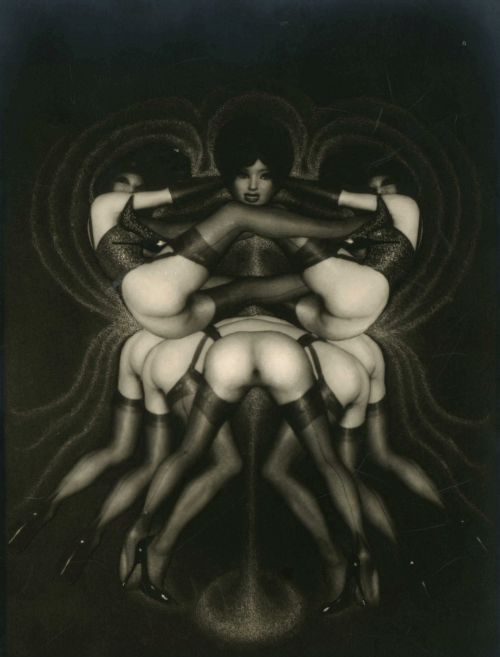
Pierre Molinier. Sur le pavois, planche 26 du Chaman. 1968
And finally, the third step, crossing into another dimension. The Molinier exhibition was not about the obscene, or about the vulgar, or about breaking down boundaries, or especially about sex. It was actually about the typical.
First of all, Molinier was a phenomenon of the typical French. It is a continued pseudo-complexity and pseudo-depravity driven to the limit underneath which there is an presumingly bored and rather cowardly bourgeois spirit. You should read the aforementioned Bataille or Robbe-Grillet, watch Raul Ruiz’s film “The Hypothesis of the Stolen Painting” (original prose written by Pierre Klossowski). Secondly, Molinier made typically late surrealist art. There is plenty of confusion when it comes to surrealism, partly about its seemingly “revolutionary”, “rebellious”, “subversive” spirit. Perhaps it was partly so at its earliest stage. But as for late surrealism (not even mentioning what was happening after World War II), it was about something completely different. First of all, it was about money, about how to portray mysterious and beautiful art, and about fooling the audience by pinching its money. Late surrealism is a not so young but elegant gigolo leading a pleasant social life with the money of an enamored rich heiress. This uncomplicated idea is perfectly illustrated by the biography and especially the photography of Max Ernst.
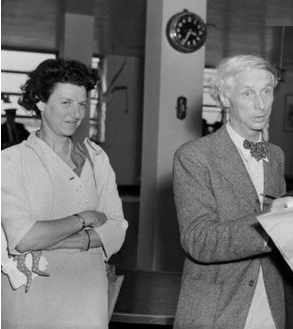
Max Ernst and Peggy Guggenheim
As a result, surrealism that arose from the truly revolutionary Dada finished its story as a supplier of spectacular images for advertising. And the art of those who did not succeed in this, such as Pierre Molinier for example, became a sweet delight for quiet vulgar men with a small but steady income and attempts at old secular demonism.
Finally, thirdly, this is typical bourgeois art. Since the 19th century it was actually the bourgeoisie, not the church or the aristocracy, who set the “general rules”, in particular, the aesthetic and ethical rules. After that, the bourgeoisie immediately started to quietly violate those rules, particularly because it was done without any risks because that was the same institution that set them! All this boasted transgression did not cross the boundaries of Pierre Molinier’s atelier-boudoir. Marquis de Sade had quite a different scale.
In 1955 Pierre Molinier got in contact with Andre Breton. The top regiment of the French surrealists were doing terribly well and very badly at the same time. On the one hand, the surrealists finally became a part of the “intellectual and artistic elite” of France, they had been unconsciously incorporated into a personal list of the special national heroes’ Pantheon. They had exhibitions one after another, their catalogues became more and more luxurious, the prices for any old scribble got higher and higher. There were exceptions, of course, but the trend remained. Impudent young Lettrists and Situationists in the 50s already considered Bataille and Breton respectable “papas”. The triumph was the defeat of late surrealism. Surrealism had lost its drive. Surrealism had lost its own vision of the future. Surrealism had lost the ability to terrify a man on the street, I mean, how can you scare people who lived through World War II? Surrealists became aging freaks whose names were in your ear, and they were harmless. Breton was no longer shaking his fists (although he tried), he was putting his collection of curiosities in order in his Paris apartment. And that was when he came across Pierre Molinier. Molinier was perfect for Breton and late surrealism in general as a hardworking manufacturer of crafty obscenities. Breton helped Molinier with exhibitions, and they even developed a correspondence. In the film, Dominique Roland has a curious scene involving that same brothel that Molinier gave money to. The artist writes to Breton, concerned by the pause in the epistolary, saying, have you decided to break up with me, dear Andre, after finding out that your correspondent has opened a brothel? “Why would you think that! No, no!” was Breton’s response, “on the contrary! It is a great honor for me! A brothel is so cool!”
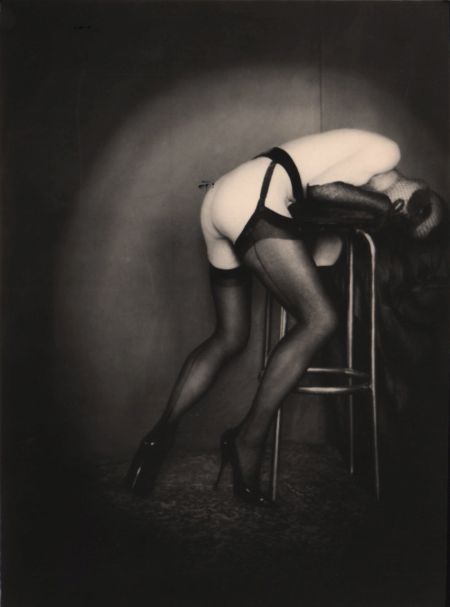
Pierre Molinier. Study for Mandrake se regale (Mandrake’s Pleasure). 1967
In 1976 Pierre Molinier shot himself standing by the same mirror with the help of which he photographed himself in various amusing poses. It is said that his health had deteriorated a lot by that point, and it really bothered the artist. And it was only recently, already as a rather aging man, he could soul-fulfillingly perform fellatio on himself all he wanted!